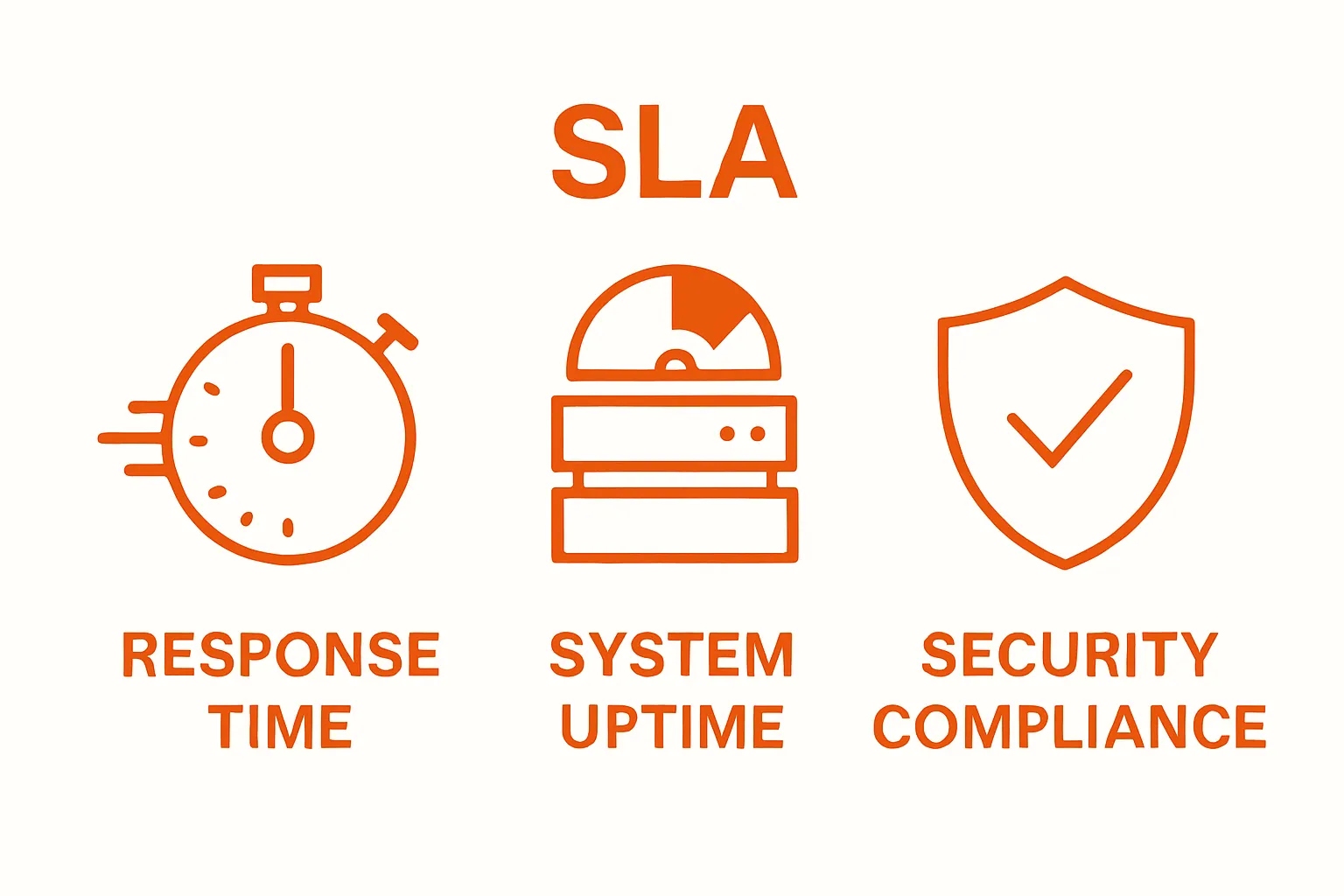
Understanding IT Service Level Agreements for Businesses
IT Service Level Agreements sound like boring paperwork for tech teams. But here’s a shocker. Businesses with solid SLAs can slash technology-related disruptions by up to 40 percent, according to Gartner. Most folks expect SLAs to be stuffy legal forms but they transform tech support into a powerful shield that keeps your business running no matter what comes your way.
Table of Contents
- What Are IT Service Level Agreements?
- The Importance Of IT Service Level Agreements In Business
- How IT Service Level Agreements Work
- Key Concepts And Components Of IT Service Level Agreements
- Real-World Applications Of IT Service Level Agreements
Quick Summary
| Takeaway | Explanation |
|---|---|
| IT SLAs clarify service expectations | They define service scope, performance metrics, and responsibilities between providers and clients clearly. |
| Robust SLAs reduce operational risks | Organizations can decrease downtime by up to 60% through structured agreements, protecting against system disruptions. |
| SLAs create financial predictability | By outlining clear terms, SLAs help businesses budget accurately for IT support and predict costs. |
| Continuous performance monitoring is key | Effective SLAs employ tracking tools for KPIs, ensuring consistent service quality and rapid incident response. |
| SLAs are strategic partnerships | They align technology capabilities with business goals, enhancing support and promoting organizational growth and innovation. |
What Are IT Service Level Agreements?
An IT Service Level Agreement (SLA) represents a critical contractual document that defines the specific parameters of technology support and service delivery between an IT service provider and a business client. These legally binding agreements outline precise expectations, performance standards, and responsibilities that ensure technology infrastructure operates smoothly and efficiently.
The following table summarises the core components commonly found in IT Service Level Agreements (SLAs), providing a quick reference for understanding their structure and function in business contexts.
| Core Component | Description |
|---|---|
| Service Scope | Defines the specific IT services provided and their boundaries |
| Performance Metrics | Establishes measurable standards for service quality |
| Response and Resolution Times | Outlines expected timeframes for addressing and resolving issues |
| Availability Guarantees | Commits to predetermined system uptime percentages |
| Roles and Responsibilities | Clarifies duties of both provider and client |
| Financial Terms | Details pricing structure and any penalty or credit mechanisms |
Core Components of an IT Service Level Agreement
IT service level agreements are comprehensive documents that articulate multiple critical aspects of technical support. These agreements typically include:
- Service Scope: Detailed description of exact IT services being provided
- Performance Metrics: Specific measurable standards for service quality
- Response and Resolution Times: Expected timelines for addressing technical issues
- Availability Guarantees: Committed uptime percentages for critical systems
The primary purpose of an SLA is to establish clear communication channels and set unambiguous performance benchmarks. Learn more about service agreements with our detailed guide that breaks down how businesses can effectively implement these critical contracts.
Understanding SLA Measurement and Accountability
Measurement forms the backbone of any effective IT service level agreement. Providers typically use sophisticated monitoring tools to track key performance indicators (KPIs) that demonstrate their commitment to service quality. These measurements might include:
- Mean time to respond to technical issues
- System downtime percentages
- Number of resolved tickets within specified timeframes
- Security incident response rates
According to Gartner Research, businesses that implement robust SLAs can reduce technology-related disruptions by up to 40% and significantly improve overall operational efficiency. By establishing clear expectations and accountability mechanisms, organizations create a structured approach to managing their technological ecosystems.
This table presents key quantitative outcomes and research findings related to the effectiveness of IT Service Level Agreements in reducing disruptions and improving operational reliability for businesses.
| Statistic / Source | Business Outcome |
|---|---|
| Gartner Research | Up to 40% reduction in technology-related disruptions |
| McKinsey Research | As much as 60% decrease in operational downtime with robust SLAs |
| Deloitte Technology Research | Up to 55% reduction in technological disruptions via industry-specific SLAs |
| Enhanced Monitoring (ITIL) | Improved service quality and faster incident response |

Effective IT service level agreements transform technology support from a reactive process to a proactive partnership, ensuring businesses receive consistent, reliable, and high-quality technical services tailored to their specific operational requirements.
The Importance of IT Service Level Agreements in Business
IT Service Level Agreements transcend mere paperwork to become strategic instruments that protect and optimize an organization’s technological capabilities. These comprehensive agreements serve as fundamental safeguards that ensure businesses receive reliable, predictable, and high-quality technological support tailored to their unique operational requirements.
Strategic Risk Management and Operational Continuity
Businesses operate in increasingly complex technological environments where system disruptions can result in substantial financial losses. Our detailed guide on IT support explains how robust service agreements mitigate operational risks. SLAs provide critical protection by:
- Establishing clear accountability for technology performance
- Defining precise resolution timelines for technical issues
- Creating transparent mechanisms for addressing service failures
- Providing financial protections through service credits or penalty clauses
According to McKinsey Research, organizations with well-structured IT service level agreements can reduce operational downtime by up to 60% and significantly improve technological resilience.
Financial and Operational Predictability
Beyond risk management, SLAs offer substantial financial and operational benefits. They transform technology support from an unpredictable expense into a structured, manageable investment. By clearly defining service parameters, businesses can:
- Budget accurately for technology support
- Predict potential service interruption costs
The financial implications are substantial. A comprehensive SLA allows businesses to understand exactly what technological support they will receive, when they will receive it, and under what conditions. This clarity enables more strategic technological planning and investment, turning IT support from a reactive cost center into a proactive business enabler.
Ultimately, IT Service Level Agreements represent more than contractual documents. They are strategic partnerships that align technological capabilities with business objectives, ensuring that technology becomes a powerful catalyst for organizational growth and innovation.
How IT Service Level Agreements Work
IT Service Level Agreements function as sophisticated operational blueprints that transform technological support into a structured, measurable process. These agreements create a comprehensive framework that defines how technology services will be delivered, monitored, and maintained with precision and accountability.
Performance Measurement and Monitoring Mechanisms
The operational essence of an SLA lies in its detailed performance tracking systems. Explore our in-depth support resources to understand the intricate monitoring techniques used in service agreements. Typically, these mechanisms involve:
- Real-time system performance tracking
- Automated incident detection and reporting
- Continuous uptime monitoring
- Detailed performance metric documentation
According to ITIL Foundation Research, effective SLA monitoring involves establishing clear key performance indicators (KPIs) that provide objective measurements of technological service quality.
Escalation and Resolution Protocols
Critical to SLA functionality are well-defined escalation procedures that ensure technical issues are addressed systematically and efficiently. These protocols typically establish:
- Hierarchical problem-solving workflows
- Specific response time commitments
- Clear communication channels for reporting issues
- Predetermined resolution strategies for different severity levels
The escalation process transforms potential technological disruptions into managed, predictable interventions. By creating structured pathways for addressing technical challenges, businesses can minimize potential operational interruptions.
Unlike traditional support models, modern IT service level agreements operate as dynamic, intelligent systems that continuously adapt to an organization’s evolving technological requirements. They represent a proactive approach to technology management, where service providers are not just responders but strategic partners committed to maintaining optimal technological performance.
Key Concepts and Components of IT Service Level Agreements
IT Service Level Agreements represent sophisticated contractual instruments that encompass multiple intricate components designed to ensure comprehensive technological support and operational reliability. These agreements go beyond simple service descriptions to create robust frameworks that align technological capabilities with business objectives.
Critical Structural Elements
The foundational structure of an SLA consists of interconnected elements that define the scope, expectations, and accountability of technological services. Our comprehensive guide helps businesses understand service agreement nuances. These critical structural elements typically include:
- Service Definition: Precise description of technological services provided
- Performance Metrics: Quantifiable standards measuring service quality
- Roles and Responsibilities: Clear delineation of provider and client obligations
- Financial Terms: Pricing structures and potential penalty mechanisms
According to International Standards Organization Research, well-constructed SLAs should provide unambiguous, measurable parameters that protect both service providers and client organizations.
Comprehensive Performance Parameters
Performance parameters form the quantitative backbone of IT Service Level Agreements. These parameters transform abstract service promises into concrete, measurable commitments. Key performance indicators typically encompass:
- Response time for technical support requests
- System availability and uptime percentages
- Mean time to resolve technical incidents
- Security compliance and risk management metrics
These performance parameters create a transparent mechanism for evaluating technological service quality, enabling businesses to objectively assess their IT support infrastructure.
 By establishing clear, measurable standards, SLAs convert technological support from an unpredictable expense into a strategic, manageable resource that directly contributes to organizational efficiency and operational resilience.
By establishing clear, measurable standards, SLAs convert technological support from an unpredictable expense into a strategic, manageable resource that directly contributes to organizational efficiency and operational resilience.
Real-World Applications of IT Service Level Agreements
IT Service Level Agreements transcend theoretical frameworks to become practical tools that solve complex technological challenges across various industry sectors. These strategic documents enable businesses to manage technological risks, optimize operational efficiency, and establish clear expectations for technology support.
Industry-Specific SLA Implementation
Different industries leverage SLAs uniquely to address their specific technological requirements. Discover how targeted service agreements transform business technology. Practical applications vary across sectors:
- Financial Services: Ensuring transaction system reliability and cybersecurity compliance
- Healthcare: Maintaining patient data protection and medical system uptime
- Manufacturing: Guaranteeing continuous production system performance
- Retail: Supporting e-commerce platform stability and customer transaction systems
According to Deloitte Technology Research, organizations with industry-specific SLAs can reduce technological disruptions by up to 55% and improve overall operational resilience.
Strategic Technology Risk Management
Beyond immediate technical support, SLAs function as sophisticated risk management tools that protect organizational technological infrastructure. These agreements provide comprehensive protection by:
- Establishing clear technological performance standards
- Creating financial safeguards against service failures
- Defining precise incident response and resolution protocols
- Ensuring continuous technological system improvements
Modern IT Service Level Agreements represent more than contractual documents. They are strategic partnerships that align technological capabilities with business objectives, transforming technology from a potential liability into a robust, predictable operational asset that drives organizational growth and innovation.
Take Control of Your IT Confidence with Trusted Service Level Agreements
Struggling with unplanned downtime or unclear technology support is more common than you might think. When ambiguity surrounds your IT service level agreements, your business faces unpredictable risks and operational slowdowns. You deserve technology support that is accountable, measurable, and transparent. At Techtron, we transform your understanding of SLAs into real-world outcomes by ensuring clear performance benchmarks, strict uptime guarantees, and proactive issue resolution for every client. Our fully managed and co-managed IT solutions are specifically designed for professional firms and mid-sized companies who cannot afford unexpected IT disruptions or compliance uncertainties.
Ready to move from reactive fixes to a long-term, reliable technology partnership? Discover how our structured approach to risk management and operational continuity will protect your business and empower your growth. Visit Techtron now to secure your IT environment with tailored service level agreements built for your business size and industry. Take the next step to safeguard your operations and enjoy predictable IT support starting today.
Frequently Asked Questions
What is an IT Service Level Agreement (SLA)?
An IT Service Level Agreement (SLA) is a formal document that outlines the expected technology support and service delivery between an IT service provider and a business client, detailing performance standards and responsibilities.
What components are typically included in an SLA?
An SLA usually includes service scope, performance metrics, response and resolution times, and availability guarantees to ensure effective communication and accountability regarding technology support.
How do SLAs contribute to risk management in businesses?
SLAs help mitigate operational risks by establishing clear accountability for technology performance, defining resolution timelines for technical issues, and providing transparent mechanisms for addressing service failures, thus ensuring operational continuity.
What are some key performance indicators (KPIs) used in SLAs?
Common KPIs in SLAs include mean time to respond to technical issues, system downtime percentages, number of resolved tickets within specified timeframes, and security incident response rates.